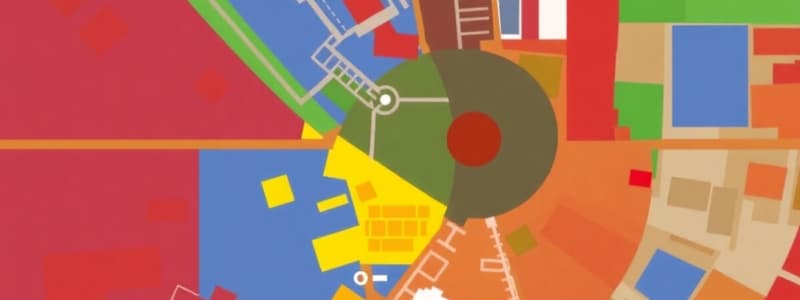Podcast
Questions and Answers
How does the Sector Theory differ most significantly from the Concentric Zone Model?
How does the Sector Theory differ most significantly from the Concentric Zone Model?
- It focuses primarily on residential segregation based on ethnicity.
- It highlights the importance of the central business district (CBD).
- It emphasizes the role of transportation corridors in shaping urban development. (correct)
- It proposes that urban growth occurs in rings rather than sectors.
According to the Sector Theory, what role do high-income residential areas play in urban expansion?
According to the Sector Theory, what role do high-income residential areas play in urban expansion?
- They typically develop near transportation hubs to allow greater access to employment opportunities.
- They are evenly distributed to promote social diversity across all sectors.
- They serve as barriers that limit the expansion of low-income areas. (correct)
- They encourage the expansion of industrial zones.
In the context of the Sector Model, how would a new highway influence urban development?
In the context of the Sector Model, how would a new highway influence urban development?
- It would primarily affect the location of parks and recreational areas.
- It would likely stimulate industrial and commercial growth along its path, influencing the development of associated housing sectors. (correct)
- It would lead to uniform growth in all directions from the city center.
- It would decrease property values in surrounding residential areas due to increased traffic.
According to the Sector Theory, what is the typical spatial relationship between industrial zones and low-income housing?
According to the Sector Theory, what is the typical spatial relationship between industrial zones and low-income housing?
Which of the following best explains how the Sector Theory models urban areas?
Which of the following best explains how the Sector Theory models urban areas?
What aspect of urban development does the Sector Theory primarily emphasize?
What aspect of urban development does the Sector Theory primarily emphasize?
Which is a key assumption of the Sector Theory regarding land use patterns?
Which is a key assumption of the Sector Theory regarding land use patterns?
What happens when a high-income residential sector expands, according to the Sector Theory?
What happens when a high-income residential sector expands, according to the Sector Theory?
What would be the LEAST likely outcome of increased investment in public transportation radiating from the CBD, according to the Sector Model?
What would be the LEAST likely outcome of increased investment in public transportation radiating from the CBD, according to the Sector Model?
How does the Sector Theory account for the impact of natural barriers, such as rivers or mountains, on urban shape and growth?
How does the Sector Theory account for the impact of natural barriers, such as rivers or mountains, on urban shape and growth?
Flashcards
Sector Theory (Hoyt Model)
Sector Theory (Hoyt Model)
Urban land use model proposed by Homer Hoyt in 1939 that emphasizes growth along transportation routes and sectors.
Sectoral Growth
Sectoral Growth
Growth occurs outward from the CBD in wedge-shaped sectors, following transportation corridors.
CBD – Central Business District
CBD – Central Business District
The core area of a city where business and offices are concentrated.
Industry/Transportation Sector
Industry/Transportation Sector
Signup and view all the flashcards
Low-income Housing (Sector Model)
Low-income Housing (Sector Model)
Signup and view all the flashcards
Middle-income Housing (Sector Model)
Middle-income Housing (Sector Model)
Signup and view all the flashcards
High-income Housing (Sector Model)
High-income Housing (Sector Model)
Signup and view all the flashcards
Directional/Sectoral Growth
Directional/Sectoral Growth
Signup and view all the flashcards
Transportation Lines (Sector Model)
Transportation Lines (Sector Model)
Signup and view all the flashcards
Concentric Zone Model
Concentric Zone Model
Signup and view all the flashcards
Study Notes
Sector Theory (Hoyt Model)
- Proposed in 1939 by land economist Homer Hoyt
- A modification of Burgess’ Concentric Zone Model
- Focuses on urban land use based on transportation lines and sectoral growth
Key Features
- City growth occurs in sectors or wedges
- Sectors grow outward from the CBD along transport corridors
- Social groups and land uses arranged by direction, not distance
- Better residential sectors grow along desirable areas
- Industrial areas grow along rail lines or transport routes
Main Land Use Sectors
- The Central Business District (CBD) is the core zone of business and offices
- Industry/Transportation grows along railway lines and highways
- Low-income housing is located close to industries and transport lines
- Middle-income housing is located between low and high-income areas
- High-income housing is located away from industries, in green, clean corridors
Key Points
- Focus on directional/sectoral growth
- Housing and land uses follow transport lines
- Wedges can extend radially from the CBD
- High-class residential areas often act as barriers to low-income expansion
Studying That Suits You
Use AI to generate personalized quizzes and flashcards to suit your learning preferences.




